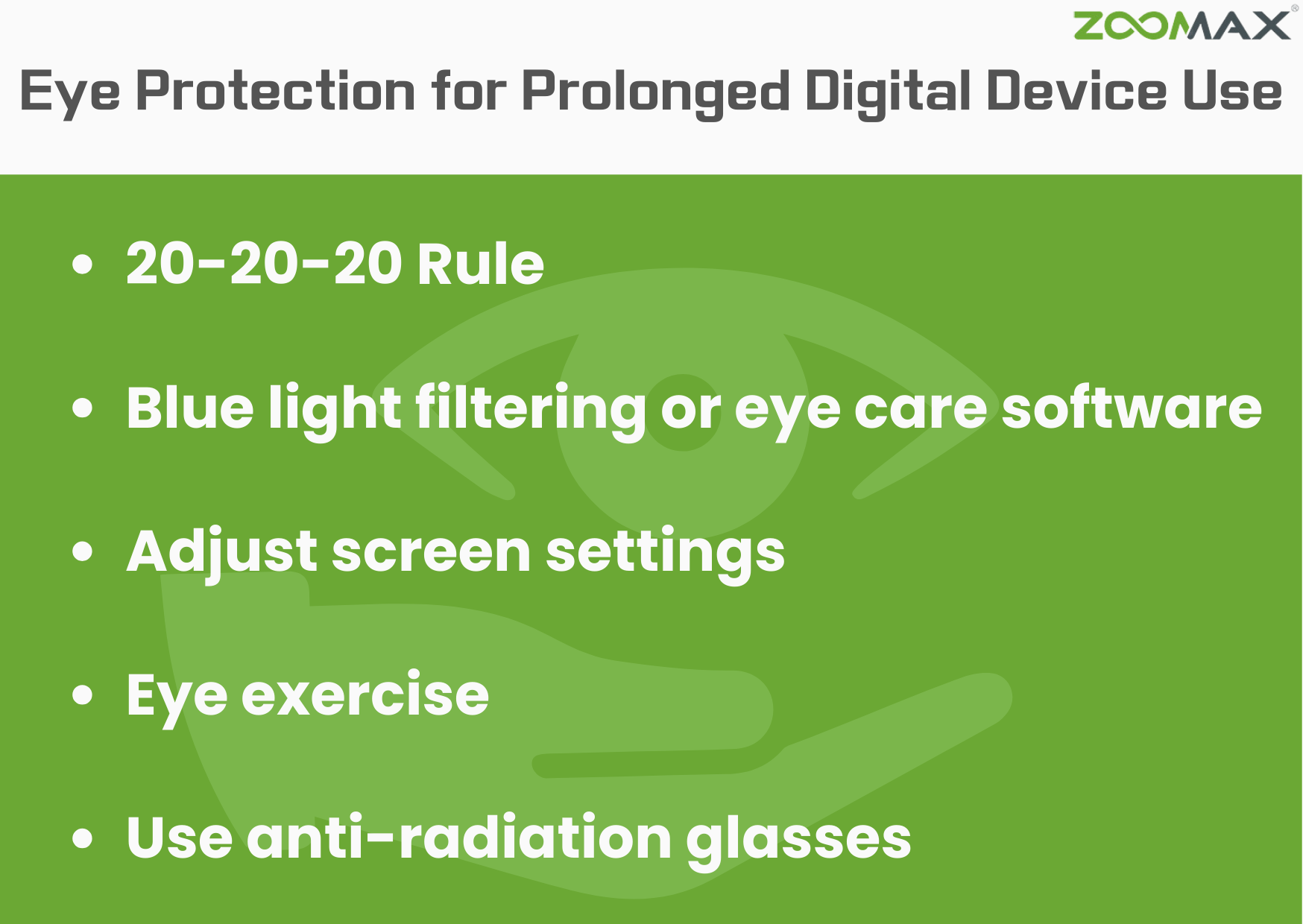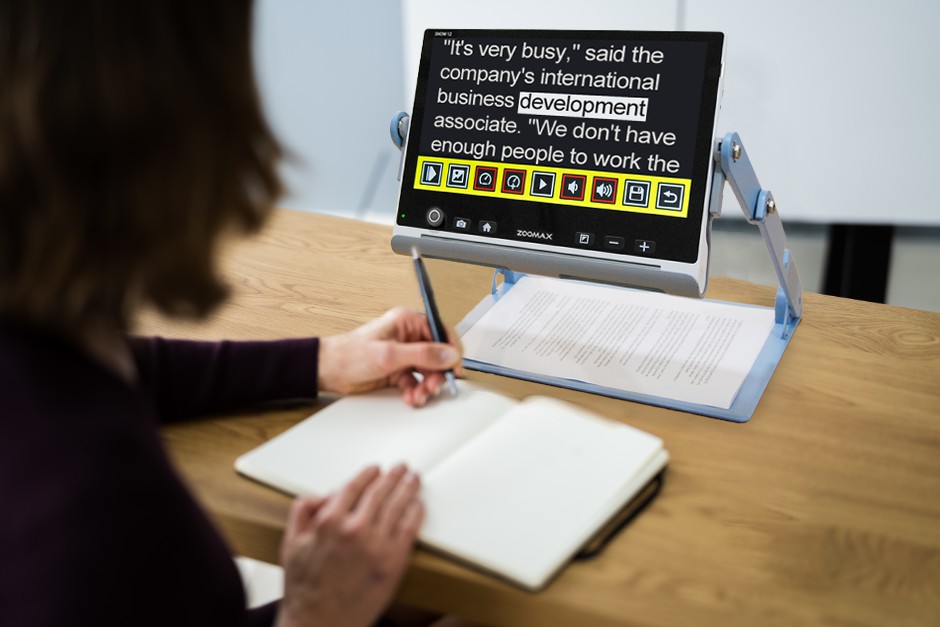In today's fast-paced digital world, where screens have become widespread in our everyday lives, people living with low vision face unique challenges that affect their ability to effectively navigate and communicate with digital content. With the development of smartphones, tablets, laptops, and other digital devices, people with visual impairments confront major challenges in using visual displays.
 According to a study conducted by the American Foundation for the Blind (AFB), people with low vision experience unique challenges while using digital screens, ranging from difficulty seeing small text to identifying small details. These problems not only cause greater eye strain but also represent a risk to their overall eye health. In this thorough guide, we look at various challenges facing low vision in the digital era and offer concrete techniques and technology to improve accessibility and promote enhanced eye health for those with visual impairments.
According to a study conducted by the American Foundation for the Blind (AFB), people with low vision experience unique challenges while using digital screens, ranging from difficulty seeing small text to identifying small details. These problems not only cause greater eye strain but also represent a risk to their overall eye health. In this thorough guide, we look at various challenges facing low vision in the digital era and offer concrete techniques and technology to improve accessibility and promote enhanced eye health for those with visual impairments.
Low Vision Challenges with Digital Screens
Individuals with low vision have specific challenges when engaging with digital devices, worsening an already complex environment of digital accessibility. Visual acuity limits have significant effects on the ability of people with conditions including macular degeneration, diabetic retinopathy, and glaucoma to engage with digital content. One of the most difficult issues for people with low vision is reading information on digital devices. Small fonts, poor contrast, and glare provide substantial challenges for those with visual impairments to recognize and comprehend information effectively. As a result, things like reading emails, surfing websites, and utilizing applications become difficult and often unattainable.
 Furthermore, the changing nature of digital interfaces adds further challenges for those with low vision. Interactive features like dropdown menus, sliders, and buttons may not be correctly labeled or accessible, making navigation and functionality difficult. Individuals with low vision may struggle to execute necessary tasks independently if adequate modifications are not made, resulting in stress and less productivity. Furthermore, the increasing availability of multimedia content, such as photographs and videos, creates issues for those with low vision challenges who rely on alternate forms to obtain information. Individuals with low vision may be unable to engage with digital media if there are no adequate descriptions or subtitles.
Furthermore, the changing nature of digital interfaces adds further challenges for those with low vision. Interactive features like dropdown menus, sliders, and buttons may not be correctly labeled or accessible, making navigation and functionality difficult. Individuals with low vision may struggle to execute necessary tasks independently if adequate modifications are not made, resulting in stress and less productivity. Furthermore, the increasing availability of multimedia content, such as photographs and videos, creates issues for those with low vision challenges who rely on alternate forms to obtain information. Individuals with low vision may be unable to engage with digital media if there are no adequate descriptions or subtitles.
For those with low vision, extended use of digital screens can worsen eye strain and tiredness in addition to accessibility issues. Extended periods of screen use for work, education, and enjoyment can cause pain and contribute to general eye health difficulties. Given the widespread use of digital devices in many aspects of everyday life, from education to entertainment to communication, tackling the issues of low vision with digital screens is critical to guaranteeing equitable access and opportunity for those with visual impairments.
Eye Protection for Prolonged Digital Device Use
In today's digital era, when displays have become a vital part of daily life, it is critical to safeguard eye health while using digital devices for extended periods of time, particularly for people with low vision. Continuous exposure to screens, along with the blue light generated by digital gadgets, can cause eye strain, fatigue, and discomfort, compounding the difficulties experienced by persons with visual impairments.
20-20-20 Rule
The 20-20-20 rule is a powerful yet straightforward strategy from eye care experts that can help mitigate the negative effects of extended screen use. The principle recommends taking a 20-second break every 20 minutes to concentrate on something 20 feet away. This brief gap helps the eyes to relax and refocus, decreasing the strain and tiredness caused by extended screen use. Incorporating the 20-20-20 rule into regular digital device usage routines can considerably reduce eye strain and improve general eye health for people with low vision.
Blue light filtering or eye care software
Another essential component of eye protection is the use of blue light filtering devices and eye care software. Blue light produced by digital devices has been related to sleep disturbances and increased eye strain. Individuals with limited eyesight can reduce the negative effects of long-term screen exposure by adopting equipment or software that filters out blue light or modifies screen color temperature. These solutions lessen eye strain and tiredness, allowing more comfort and long-term usage of digital gadgets.

Adjust screen settings
In addition, modifying screen settings such as brightness, contrast, and font size can have a substantial influence on eye comfort and read for those with low vision. For people with visual impairments, larger font sizes, better contrast, and less screen glare can all help make digital information less complicated to read and more accessible. Customizing these settings to meet your personal preferences and visual demands can significantly improve the overall user experience while lowering the risk of eye strain and fatigue.
Eye exercise
In addition to preventive measures like the 20-20-20 rule and blue light filtering, adding blinking routines and eye stretches into daily routines can assist preserve eye health and comfort throughout extended digital device usage. Blinking lubricates the eyes and prevents dryness, while moderate eye stretches relieve stress and strain. These straightforward but effective exercises can be done daily to improve eye comfort and lessen the risk of pain caused by prolonged screen usage.
Use anti-radiation glasses
Individuals with low vision challenges may also consider using anti-radiation glasses, which are designed to reduce exposure to hazardous electromagnetic radiation released by digital screens. These glasses assist in decreasing eye strain and tiredness, adding an extra layer of protection for those with visual impairments who rely extensively on digital devices in their everyday activities.
People with low vision may successfully safeguard their eye health and reduce the risk of discomfort associated with prolonged screen time by implementing these proactive tactics and technology into their regular digital device usage routines. Prioritizing and adopting eye safety measures can dramatically improve the overall well-being and quality of life for those with visual impairments in the digital age.
Support for the Low Vision in the Digital Era
Technological advancements have resulted in the creation of bespoke digital assistive solutions that are specifically designed for the needs of people with low vision. These technologies include a wide range of equipment and software programs that aim to improve usability and accessibility for people with varied degrees of vision impairment. Electronic video magnifiers, screen readers, voice-controlled assistants, and tactile interfaces are some of the numerous solutions available to help people with impaired vision interact more easily with digital information and gadgets.
Devices such as Zoomax electronic video magnifiers provide practical solutions for those with low vision by giving clear, enlarged images and configurable settings to match their specific needs. In most cases, Snow 12, Luna 6, and Luna 8 are revolutionary low-vision aids designed to meet unique requirements and preferences, improving accessibility and usefulness for those with visual impairments. These types of low vision aids help visually impaired people with their everyday tasks and enhance their living independence.
 Incorporating low vision aids into digital accessibility projects is critical to establishing a more inclusive online world. Individuals with limited vision can overcome restrictions and fully engage in the digital world by using technologies such as Zoomax electronic video magnifiers.
Incorporating low vision aids into digital accessibility projects is critical to establishing a more inclusive online world. Individuals with limited vision can overcome restrictions and fully engage in the digital world by using technologies such as Zoomax electronic video magnifiers.
To summarize, tackling the issues of low vision in the digital era necessitates an integrated approach that includes proactive eye safety measures, new assistive technology, supportive online communities, and mental health services. By employing these techniques and using technology improvements, we can make the digital world more inclusive and accessible for people with low vision, increasing their self-reliance, well-being, and quality of life. With ongoing work and cooperation, we can make sure that every person, regardless of visual ability, can prosper in the digital age.

